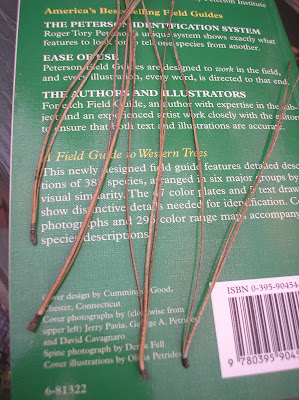We live in an area where the predominant trees are oaks and pines. Pines usually are taller than the oaks so it is easy to pick them out of the landscape. We can stand on our back deck and see dozens of pines and oaks. We have identified a few of them by name but we still have some trees to work on getting to know. The tall pine in the photo above we identified as a Gray pine or Digger pine. Pinus sabiniana. It is native to our area.

Pines are usually identified by looking at the needles. This particular pine has needles in bundles of three. The needles are a gray-green color and are about 7-14 inches in length.

Here is a cone that we found under the tree. Our field guide says, "They are brown, long-stalked, uneven-based, and equipped with strong, downward-pointing, 1/2 to 3/4 inch thorns. "
Of interest to me, the seeds were once an important food of Native American. They also ate the buds and soft green cones from this pine. Of course, squirrels love the seeds too.
"The appearance of the unripe cone is another convincing evidence that mathematics is the basis of the beautiful. The pattern of the overlapping scales is intricate and yet regular-to appreciate it one needs to try to sketch it....The shape of the scales of the cone is another distinguishing characteristic of the pine, and sketching the outside of the scales from several different species of pine cones will develop the pupils' powers of observation..."It sounds like the basis of another day's nature study to me. I will gather a few different cones and have them on hand.
The Handbook of Nature Study, page 672

This photo is my attempt to show you how the color of the needles on this pine are a gray-green color and not the dark green of some of the other pines we have in our area.
Now for a pine tree story. This pine is a Monterey pine and is not native to our area. They do grow naturally along the coast of California but we live in the Sierra Nevada Foothills. The previous owners of our home must have planted it in the yard and we have watched it grow in the last twenty years to a towering height over our property.

Earlier this year we cut down this huge Monterey pine. It had grown too close to our propane tank and out over the whole lawn. Its roots were pushing up the sidewalk and we were afraid it would soon get into the water pipe we have running from the front to the back of the property. It had to come down.

Here is a photo of the men in the tree as they limbed the branches and lowered them down. Some of the branches were as big as tree trunks. This was a mighty big tree. I could hardly watch the workers as the scurried up and down the tree trunk and then way out onto the limbs to cut sections off. Note the sweet gum tree in the foreground and how it has no leaves but the pine is still green.

Here is the trunk all neatly cut into chunks. We had a friend who took the wood and is drying it to use in their woodstove. We never liked pine to burn but some people love the heat it gives off. This was the perfect opportunity to observe the trees rings up close.

Here is a close up photo of the sap seeping out from the downed tree trunk. It was very sticky. I know from personal experience. :)

The other interesting thing to note about the pine was the thickness of the bark. The pattern of the edge was so pretty.

Here are some cones that came from the tree. I shared this photo before but it really shows how the cone opens up as it matures to allow the seeds to be exposed.
It was sad to watch the tree be cut down but now that it has been some months we can see the difference in the surrounding trees. They have ample sunlight now and they are filling out their branches. One oak in particular seems to have really benefited from the pine removal. Our lawn is so much greener now that it isn't constantly covered in needles.
We will be observing more pines as the focus continues but I thought we could share our special tree cutting down story in this entry.


A great study, of course! We studied the rings and such on our cut trees back when we cut them down, and watching them come down really made an impression on my daughter, too!
ReplyDeleteI'm hoping to get around to studying pines this week, but I'm not sure we'll make it.
ReplyDeleteI'm glad you are enjoying my hippo photo. Isn't it unusual to see them out of the water? And, I love your caption. :-) And, you may use it on your computer!
What a great pine tree story!
ReplyDeleteYou really made it into a study.
There is so much to learn around us!
I love the photo's of the tree rings. Something about that has always fascinated me... I enjoyed discovering in the HNS this week that the branches and twigs have similar rings. I never knew that...
ReplyDelete